It is with some trepidation that I attempt to tell the story of the third incarnation of the National Museum of Natural History’s paleontology exhibits. For one thing, this was “my” space, insofar that any of us feel ownership over familiar public spaces. I explored these halls regularly as a toddler. I volunteered there as a teenager and interned there after college. More recently, I’ve found myself working among these same displays on a number of occasions as a museum professional*. As such, it is difficult to establish an appropriate amount of cognitive distance, even now that the galleries have been cleared from wall to wall, and new exhibits are being installed in their place.
“Fossils: History of Life” closed for renovation in April 2014. Because this exhibition existed largely unchanged for most of my life, a part of me likes to think of it as something that has always been there. Nevertheless, these displays were designed and built by specific people at a specific point in time. And while the specimens, artwork, and craftsmanship in Fossils: History of Life were nothing short of iconic, the process of putting those pieces together was surprisingly contentious. The creation of this exhibition was beset by internal strife and controversy, as conflicts that had been simmering for decades about the very nature of museums finally came to bear.
The Story So Far
The east wing of the National Museum of Natural History (prior to 1964, the United States National Museum) has been home to fossil displays since the current building opened in 1910. From opening day to 1945, the exhibits were primarily under the stewardship of Curator of Vertebrate Paleontology Charles Gilmore. Intermittently called the “Hall of Extinct Monsters,” this iteration was somewhat haphazard in its layout. Like many early 20th century exhibitions, the galleries were filled with a sampling of static objects from the collections, occasionally accompanied by an explanatory painting, map, or model. Gilmore’s version of the east wing remained in place until 1962, when the space was redesigned as part of a Smithsonian-wide modernization project. Between 1953 and 1963, the modernization committee chaired by Frank Taylor oversaw improvements of nearly all of the National Museum’s exhibits. Taylor pushed for exhibitions that catered to laypeople, rather than specialists. Paths visitors might travel through the space, common visitor questions, and consistent aesthetics were all considered when overhauling the east wing fossil halls.

Modernization-era version of hall 2, completed in 1962. Photo courtesy of the Smithsonian Institution Archives.
As Rader and Cain convincingly argue, the transition from exhibits dominated by cases of specimens with minimal interpretation to story-driven learning experiences began in most American museums at the beginning of the 20th century. However, this was not the case at the Smithsonian. By the 1950s, the National Museum had developed a reputation as an old-fashioned place. Its neo-classical exhibition halls mostly contained rows of cases jam-packed with specimens, and that was the way the curatorial staff liked it. Entomologist Waldo Schmitt summed up the prevailing institutional attitude when he said that exhibits should be nothing more than “show windows for displaying our wares and accomplishments.” Curators like Schmitt worried that shoehorning objects into generalized narratives about nature and anthropology would distort or occlude their meaning and provenance. NMNH Director Remington Kellogg agreed, and Taylor’s modernization committee faced an uphill battle with every exhibit they sought to make more broadly accessible.
It was a stalemate between two competing visions for what a museum should be. The 1962 fossil hall renovation at NMNH experimented with dioramas, color-coded signage, and text divided into area titles, headings, and subheadings, but compared to peer institutions it was hardly revolutionary. This could be partially attributed to the design process, in which the development of each of the four east wing galleries (halls 2, 3, 4, and 5) was led by a different curator. As a result, the galleries landed in different places on the spectrum between traditionally-arranged specimens and cohesive narratives.
Nevertheless, a turning point was on the horizon. The east wing modernization plan also called for the annexing of hall 6 (formerly the home of geology exhibits) as a dedicated Hall of Quaternary Vertebrates. In part due to the larger number of new specimens being prepared for display, this Quaternary Hall was repeatedly delayed. By the time hall 6 was ready to reopen in 1970, its old-fashioned organization was no longer what administrators wanted. In 1973, Director Porter Kier decided to shut down the nascent Quaternary Hall and assemble a new team to redesign it. A group of geologists, anthropologists, paleontologists, and education specialists reworked the exhibit into an interdisciplinary exploration of the ice ages. Continental glaciation, the evolution and extinction of large mammals, and the rise of humans were all presented as a single, holistic story. For NMNH staff, it was clear that the 1974 Hall of Ice Age Mammals and the Rise of Man represented the future of exhibition at the museum. From that point onward, exhibit design would be a collaborative process between curators, educators, and exhibit specialists. Moreover, the galleries themselves would be seen more like fully-formed architectural spaces, rather than modular associations of artifacts. Above all, the primary purpose of exhibits would be the education and engagement of visitors.
Planning “History of Life”
After the positive reception of the Ice Age Hall, Kier were eager to retool the rest of the ever-popular paleontology galleries in the same manner. In early 1977, he appointed fossil cnidarian specialist Ian Macintyre to chair a committee of curators tasked with devising an overarching plan for the exhibit renovation. Joining Macintyre was Daniel Appelman (geology), Robery Emry (fossil mammals), Leo Hickey (fossil plants), Nicholas Hotton (fossil reptiles), Kenneth Towe (early atmosphere), and Thomas Waller (fossil mollusks). In June, the group submitted their theme statement:
The fundamental theme which has been developed in the context of a single all-encompassing hall is the history of the progress of life as revealed by the geological record in terms of:
- The great periods of time involved in the evolution of life forms preserved
- The changing environmental conditions associated with the evolutionary process
- The increase in diversity and complexity of life forms
The phrase “all-encompassing hall” is key. The curators agreed that, unlike the 1962 iteration, the new exhibit should have a single voice and follow a single narrative. This decision was influenced not only by changing expectations for exhibits, but also by recent developments in their own department. The NMNH Division of Paleontology had been disbanded in 1963, and paleontologists were reorganized into the Department of Paleobiology. The new title represented a push among research staff to focus less on descriptive systematics and more on how the fossil record can inform our understanding of evolution and ecology. Macintyre’s team wanted to bring the same change of focus to the new exhibit.
The curators spent the next year hashing out the hall in further detail. Early on, the group agreed that an illustrated column of geologic time should be the exhibit’s centerpiece. This would eventually manifest as the “Tower of Time,” with key artwork provided by John Gurche. The group also decided to break the main “progress of life” concept into several smaller storylines, which they counterintuitively called “highlights.” The highlights would include “The Earliest Traces of Life,” “Conquest of the Land,” “Reptiles: Masters of the Land,” “Living Fossils,” “Fossils and Industry,” and “Mammals in the Limelight,” among others.
Each highlight would correspond to a part of the east wing exhibit space. The central, high-ceilinged hall 2 would be occupied by Reptiles: Masters of the Land, which included the dinosaurs, as well as a substantial display of of Paleozoic marine invertebrates at the rotunda-side entrance. A new mezzanine and ramp over hall 2 would include Living Fossils, Fossils and Industry, the evolution of flight, and fossil fishes. Hall 4 would feature Earliest Traces of Life and Conquest of the Land. Mammals in the Limelight would occupy hall 3, and hall 5 would remain empty for the time being. For practical reasons, the highlights would each be overseen by a different subcommittee of specialists, and they would be built and unveiled on a staggered schedule. Still, the main committee would oversee the entire process and make sure the writing and visual design of each section came across as parts of a cohesive whole.

John Gurche’s Tower of Time was the centerpiece of the exhibit. Photo by Mary Parrish. Source
Between the lines, the need to include dinosaurs was apparently seen as a nuisance by at least some of the curators. There were no dinosaur specialists on the exhibit team, and indeed, NMNH had not employed one since Gilmore retired in 1945. Although the dinosaur renaissance was picking up speed by the late 70s, for NMNH paleontologists dinosaurs were overexposed and less interesting than their own research subjects. The museum’s eleven dinosaur mounts were decades-old relics, but their popularity among visitors obligated the curators to include them. Disarticulating and remounting the skeletons was not in the budget, and many of the dinosaurs were too big to cart out of the hall in one piece. That left the exhibit team with the unenviable task of finding places for the existing mounts in addition to all the new specimens and models they wanted to add, while still leaving enough room for visitors to get around. As internal legend has it, the giant slab of Climactichnites tracks was placed at the front of hall 2 specifically to block the view of the dinosaurs from the rotunda.

You’ll look at invertebrate fossils first, and you’ll like it! Photo by Loren Ybarrondo. Screen capture from NMNH Virtual Tour.
Although Macintyre and his curator colleagues were the only formal members of the exhibit committee, the Department of Exhibits was also involved from the start. Exhibits staff at NMNH had increased from six people in the 1960s to over 30 by 1985. This expanded force included all manner of artists, architects, industrial designers, and communications specialists, and they had an impressive on-site workshop to make use of their talents. In the 1980s, everything from silk-screened signage to cabinetry to dioramas could be created in-house. However, the increased professionalization of exhibits specialists required curators to relinquish some of the control they historically had over displays.
This, unfortunately, led to the two departments regularly butting heads. Curators complained that exhibits staff did not know enough of the science, and that the ideas they were generating simplified content to the point of being inaccurate. Meanwhile, exhibits staff had to deal with the fact that the curators had final approval authority over all content, but typically saw the exhibit work as secondary to their research obligations. Deadlines were routinely missed, leading to frenzied, last-minute crunch periods. The result was signage with avoidable errors making it the exhibit floor, and a culture of finger pointing in all directions.

This clay and paper model of the reconfigured hall 2 was produced during the planning period. Courtesy of the Smithsonian Institution Archives (but the terrible photo is my fault).

John Elliot’s Diana of the Tides fresco was briefly visible during the renovation of hall 2. Photo courtesy of the Smithsonian Institution Archives.
Two postdoctoral research associates—Jessica Harrison and George Stanley—were brought on board to help with the exhibit design and construction. Harrison and Stanley had offices in both the Exhibits and Paleobiology departments, and were well-liked by both groups of staff. The most difficult part of their job was drafting label copy. Text had to be rewritten again and again to please educators who found it too technical and content specialists who demanded more precision and detail. Harrison in particular was widely praised for effectively explaining scientific concepts to the exhibits staff and for guiding the key themes of the exhibit from concept to completion.
Specimens and Artwork
The east wing exhibits formally closed for renovation on May 29, 1979. In spite of the administrative-level disagreements, the museum’s technical staff was producing great creative work in short order. The recent expansion of the Department of Exhibits meant that nearly everything that went into the exhibit was created in-house (today, large exhibitions are often created in collaboration with contractors). Only the biggest construction projects, such as the addition of a mezzanine over hall 2, had to be contracted out.

A preparator puts the finishing touches on Eryops. Photo from Smith 1994 (previously labeled Arnie Lewis, see comments).
Scores of never-before-exhibited specimens were prepared for Fossils: History of Life. Examples include a 4.6 billion-year-old meteorite from Australia and the reconstructed jaws of Carcharocles megalodon. Preparator Arnold Lewis led the creation of the new mounted skeletons, which included Eryops and Strobodon. Some existing mounts were updated, including Dimetrodon, which was given a longer tail. The most ambitious new mount was Allosaurus, or as Hotton insisted on calling it, “Antrodemus.” The Allosaurus (USNM 4734) came to NMNH in the 1890s with the rest of the Marsh collection, but only the skull and a few other pieces had ever been displayed. Lewis spent two years creating the mount. He started by preparing the bones that had never been completely freed from the matrix they were found in. After laying the skeleton out in a giant sandbox, Lewis secured the bones one at a time to a custom steel armature. This form-fitting structure proved to be almost invisible against the dark grey bones. Unlike most theropod mounts of the time, Lewis’s Allosaurus included belly ribs, modeled in rubber after those of a crocodile.
Fossils: History of Life also called for a number of new paintings and dioramas. Peter Sawyer painted a cyclorama of a primordial Archean landscape for the Earliest Traces of Life section. Robert Hynes contributed several murals, as well, including a beach scene and a Cooksonia marsh for Conquest of the Land. In addition to the key art on the Tower of Time, John Gurche provided illustrations for the horse evolution cul-de-sac and the backdrop for a new lungfish diorama. Jay Matternes’ Cenozoic murals were carried over from the old exhibit.

Sawyer’s recreation of Archean Greenland. Photo by Loren Ybarrondo. Screen capture from NMNH Virtual Tour.

Diorama depicting the earliest land vertebrates, with a background by John Gurche. Photo by the author.
George Merchand’s marine dioramas and Norman Deaton’s dinosaur dioramas were reused, while the NMNH exhibits shop produced several brand new displays. In addition to the aforementioned lungfish scene, these included a recreation of the Burgess Shale environment and a group of eurypterids patrolling the Silurian shallows. There was also a walk-through diorama of a Cretaceous Maryland forest, featuring reconstructions of some of the earliest flowering plants.
The Smithsonian’s central exhibit shop handled the most challenging projects. Their biggest contribution was the life-sized Quetzalcoatlus model. The artists started with a clay miniature, then moved on to a 1/6th scale fiberglass model. With final approval from Nicholas Hotton and Jessica Harrison, the team moved on to the 40-foot final version. The wings were constructed like those of airplanes, with a hollow steel rod supporting wood and aluminum trusses. The wing membranes were plastic, and translucent in the right light. The head and legs were sculpted in clay then cast in plastic, and the body was covered in deer fur. Exhibits Central also built a set of cycads to accompany the historic Stegosaurus model. Several of these were real conifers, freeze dried and covered in glycerin.
Finally, Fossils: History of Life included some of NMNH’s first forays into video displays. The “Enter Life” film explored possible scenarios for biogenesis. An animated film starring “Frank Anchorfish” and “Arthur Pod” (voiced by DC-area newscasters) was a whimsical take on the challenges of moving from the aquatic to the terrestrial realm. A popular, albeit short lived, part of the exhibit was “A Star is Hatched,” which featured clips from Hollywood dinosaur movies accompanied by discussion of dinosaurs’ pop culture significance.
Legacy
On April 17, 1980, Hall 4 – with exhibits covering the origins of life, the transition to life on land, and Paleozoic and Mesozoic plants – was the first part of the east wing to reopen. The dinosaur-filled hall 2 followed on December 4, 1981. These initial phases of Fossils: History of Life were generally well-received by the public, although some media critics scoffed at the silly puns and cultural references in the label copy (“A duckbill in every pot,” “the better to eat you with, my dear,” and so forth). Robert Emry took over for Ian Macinyre as lead curator for the final phase of development and construction. After a few delays, Mammals in the Limelight in hall 3 was ready for visitors on May 30, 1985.
Behind the scenes, the occasionally tense working relationships and difficulty meeting deadlines contributed to major changes to how exhibits are put together at NMNH. When Richard Fiske took over as Director in 1983, he promoted Beth Miles, Sheila Mutchler, and Sue Voss from the Department of Exhibits to formal members of the paleontology exhibit team. A dedicated project manager position was added, and formal guidelines were prepared for exhibit-related duties. A key part of this formalized exhibit protocol was explicit acknowledgement that exhibits (not research and collections) are the public face of the museum and therefore the primary impetus for public support. Maintaining that support meant creating visitor-focused exhibits that are as relatable, educational, and entertaining as possible. This effectively killed the old idea of exhibits as mere showrooms for collections. Research and collections staff were no less important to the identity and purpose of the museum, but as far as exhibits were concerned their content knowledge would have to go hand in hand with other kinds of expertise. Exhibits and education specialists took leadership roles on future exhibit projects, a system which remains in place to this day.
Fossils: History of Life saw many changes over its 33 year life span. A Star is Hatched was one of the first displays to go. While popular among visitors, scientific staff hated the film because it trivialized exhibit content and featured long-outdated images of dinosaurs (interacting with modern humans, no less). The theater built for A Star is Hatched was eventually demolished and replaced with a windowed fossil prep lab, which became one of the most popular parts of the exhibit complex. An enclosure housing a live caiman in the Living Fossils area of the mezzanine only lasted as long as the animal. When the caiman died, the exhibit was boarded up and never replaced. Later, the Flowering Plant Revolution area – including the walk-through diorama – was dismantled to make way for a concessions stand. The largest addition to the east wing was Life in the Ancient Seas, an exhibit of marine fossils that filled the unused portion of hall 5. Completed in 1990, Life in the Ancient Seas nearly doubled the number of specimens in the fossil halls and added a splash of color with Ely Kish’s 150-foot mural of extinct marine life.

Hall 2 in 2013, with Stan the T. rex and the revised Hatcher the Triceratops in place. Photo by the author.
More recently, three of the historic dinosaur mounts were taken off exhibit and replaced with updated casts. Triceratops, Camptosaurus, and Stegosaurus had been on display since 1905, 1912, and 1913, respectively, and a century of vibration from passing crowds and fluctuating temperature and humidity had taken their toll on the fragile fossils. Ralph Chapman took the opportunity to turn the Triceratops into the world’s first digitized dinosaur, pioneering a process that is standard practice today. The Triceratops that returned to the hall in 1999 was made from foam and plastic molded directly from digital scans of the original fossils. It was accompanied by a mini-exhibit that explained how the new mount was made, and featured artwork by Bob Walters in addition to several new original and cast skulls. Shortly thereafter, NMNH acquired a cast of Stan the Tyrannosaurus as a conciliation prize for missing out on Sue. Camptosaurus and Stegosaurus were removed and replaced more quietly, but these mounts are of note because much of the casting and restoration work was done by a crew of veteran volunteers.
The mezzanine over hall 2 was closed for safety reasons after a 2011 earthquake. These exhibits never reopened, which meant that visitors could no longer see the pterosaurs, phytosaurs, and Xiphactinus. In the exhibit’s final years, an assortment of new signs were added, including updates to geologic time scale and an explanation of the dinosaur-bird connection. Unfortunately, these updates amounted to little more than bandaids for an increasingly tired exhibit.

Hall 3’s Mammals in the Limelight was delayed for over a year but finally opened in 1985. Photo by the author.
In retrospect, Fossils: History of Life was conceived at an inopportune time. Some aspects, like the focus on biology and evolution rather than classical systematics, were cutting-edge. However, much of the exhibit content was quickly outmoded by sweeping changes to the field of paleontology that occurred during the 80s and 90s. Conservative ideas about dinosaur endothermy and bird evolution were obsolete within a decade, as was much of the pre-cladistics taxonomy and the central theme of evolution as progress. The exhibit team could not have known how different our understanding of paleontology would be just a few years after the renovated halls debuted.
Moreover, the fact that Fossils: History of Life was built over the skeleton of the 1963 renovation (which was, in turn, built on top of the original east wing exhibits) proved to be a significant handicap. Since the space was never completely gutted, the designers had to work around existing specimens and structures, such as the 80-foot Diplodocus and the three separate doorways off of the rotunda. As a result, creating a logical path for visitors to follow through the halls proved impossible. Updates and additions to the exhibit only exacerbated the issue. As it stood in its final years, there was no way to view Fossils: History of Life in historical order without repeatedly doubling back. Bottlenecks that impeded traffic flow were also a problem, especially during mid-afternoon rush hour at the T. rex.
Despite these issues, Fossils: History of Life was seen – and loved – by tens of millions of visitors during its 34 years on display. After many false starts, in 2012 NMNH was finally able to secure the funding needed to overhaul the east wing properly. For the first time, the five galleries are getting a top-to-bottom revamp: every specimen has been removed and every corner of the exhibit has been redesigned, word by word and inch by inch. The bad news was that this process would take five years. Word about the lengthy closing resulted in minor outrage, particularly from parents of young children. After four decades of designing, building, maintaining, and updating the hall, Museum staff understood completely. As Director Kirk Johnson told the Washington Post, “it’s an iconic, favorite space. People have made lots of memories here.”
Additional photos are below.
*Please note that this is my personal blog and I am solely responsible for its content. For official information from NMNH and the Smithsonian Institution please see Digging the Fossil Record and the Department of Paleobiology.
References
Bohaska, S. 2013. Personal communication.
Kopper, P. 1982. The National Museum of Natural History: A Smithsonian Museum. New York, NY: Harry N. Abrams, Inc.
Marsh, D.E. 2014. From Extinct Monsters to Deep Time: An ethnography of fossil exhibits production at the Smithsonian’s National Museum of Natural History. http://circle.ubc.ca/handle/2429/50177
Park, E. 1981. A Remarkable Tower of Time Tells the Story of Evolution. Smithsonian Magazine. December 1981, pp. 99 –114.
Parrish, M. 2014. Memories of John Gurche at the National Museum of Natural History. Journal of Natural Science Illustration. 2014:1. https://gnsi.org/journal/memories-john-gurche-national-museum-natural-history
Parrish, M. 2017. Personal communication.
Post, R.C. 2013. Who Owns America’s Past? The Smithsonian and the Problem of History. Baltimore, MD: Johns Hopkins University Press.
Rader, K.A. and Cain, V.E.M. 2014. Life on Display: Revolutionizing US Museums of Science & Natural History in the Twentieth Century. Chicago, IL: University of Chicago Press.
Smith, N. 1994. Official Guide to the National Museum of Natural History/National Museum of Man. Washington, DC: Smithsonian Institution Press.
1986. Statement by the Secretary. Smithsonian Year 1985: Annual Report of the Smithsonian Institution for the Year Ended September 30, 1985. Washington, DC, Smithsonian Institution.
Thomson, P. 1985. Auks, Rocks, and the Odd Dinosaur: Inside Stories from the Smithsonian’s Museum of Natural History. New York, NY: Thomas Y. Crowell.
Wolf, R.L. and Tymitz, B.L. 1978. Whatever Happened to the Giant Wombat: An Investigation of the Impact of the Ice Age Mammals and the Emergence of Man Exhibit. Washington, DC: Smithsonian Institution.
Yochelson, E.L. 1985. The National Museum of Natural History: 75 Years in the Natural History Building. Washington, DC: Smithsonian Institution Press.


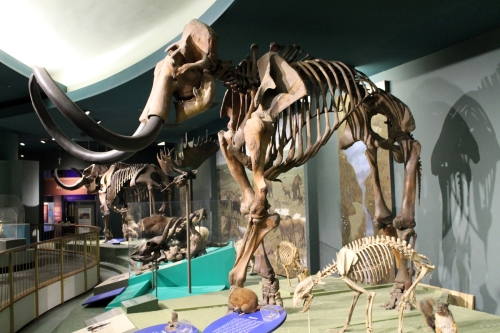





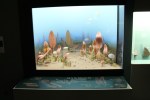
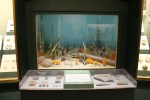
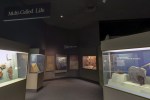

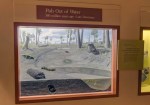


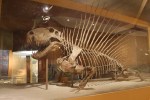


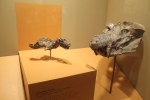
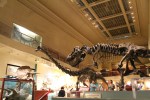

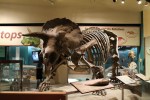
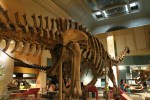
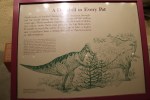
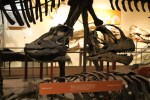

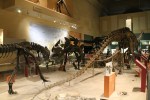
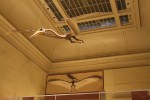
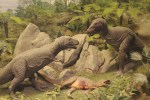


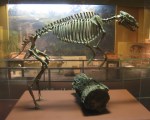
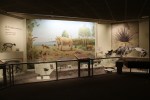
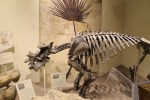
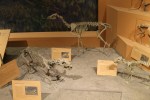
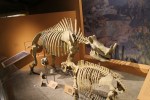
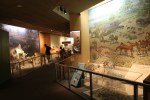
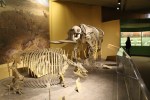

I’d say one this I think that’s great about it… it’s well lit!
I’ve seen a few where they do dramatic lighting and just made me dizzy.
I have very found memories of visiting the NMNH fossil hall in 2009. I remember spending much more time in the mammal exhibits than in the dinosaurs hall. Getting up close to Triisodon quivirensis skull (USNM 22483/22484) was a particularly transformative experience in developing my academic interest in Paleocene mammals.
Another highlight was marveling at the Jay Matternes murals. I could hardly believe the Hagerman and Beringian scenes were painted in the sixties, because they looked arguably more rigorous and “modern” than a lot of paleoart produced today. And apparently Matternes hasn’t lost his expert touch to this day. I do help they preserve the murals somehow, if only for their historical significance. (I can only find low-resolution reproductions of some paintings in a few 70s Time-Life books, and none at all of the Hagerman mural.)
Hi Jason, Kopper 1982 (full ref above) is a big coffee table book about NMNH. In addition to lots of cool specimen photos it includes full-page spreads of the Matternes murals, including the Pliocene one.
Last I heard, those murals were preserved and a couple should be going back on display.
I second Jason’s comments on the Matternes murals, and I’ll look for the Kopper book. I’ve been able to collect a number of Time Life books that include some of the murals, plus a National Geographic that includes a folded copy, but I really think Jay Matternes’ work merits a coffee table book of its own, like the books illustrating the work of Knight, Zallinger, and Burian. I don’t know if there is a name for the approach that places a large number of representative animals (and plants) in a mural, but such paintings appeared in Life’s The World We Live In in the 1950s, and also in the U.S. Postal Services’ series Nature of America stamp series, by John D. Dawson.
Getting a big, illustrated book published is probably more difficult now, but I agree that the Matternes murals are treasures, and am glad they are being preserved!
Thanks for another great article!
Hi Tom, thanks for weighing in. I don’t know if there’s an accepted name, either, but the “cross section of an ecosystem” is definitely an important style for paleoart past and present. I’ll have to check out the books you mentioned, since I’m not familiar with them.
Just fyi, Kirk Johnson did a talk last December about the plans for the NMNH exhibits. He briefly mentioned the plans for the Matternes murals (back in the exhibit, maybe included in a book) and shares some photos from a visit to Matternes’ home to see his original design illustrations. I don’t think you can link directly to a facebook video but it’s on the Smithsonian Magazine page, currently on the fifth row down: https://www.facebook.com/pg/smithsonianmagazine/videos/?ref=page_internal
I live in Colorado and took one of Kirk Johnson’s classes at the Denver Museum of Nature and Science. A very charismatic and enthusiastic pundit of all things paleo!
That IS NOT Arnie Lewis in your image of the Eryops reconstruction. I was at the SI for a year in the mid 1980s and worked with Arnie in the field (Lower Permian, North-Central TX). I don’t know who the man is in your picture, but it definitely is not him.
Bob Hook
Hi Bob, thanks for the correction. I got that photo from the children’s book “Auks, Rocks, and the Odd Dinosaur,” which may well have been captioned incorrectly.
Bob the preparator in the photo with Eryops is Leroy Glen. It was taken before 1994 because Leroy had retired by then.
Alex Downs
I came across this blog while looking for older visitor maps of NMNH to confirm which culture halls used to be where in the building. How should I cite this blog — can you send your surname for citation purposes? Or do you prefer I just cite it as extinctmonsters.net?